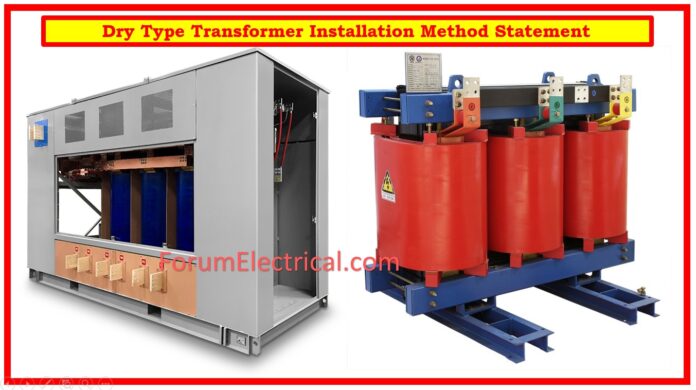The Dry type Transformer installations that are carried out on-site are included in this method of statement, which is established in the General Specification.
Scope of Work
The procedures of off-loading and installation that will be utilized to ensure that the transformers are proper and acceptable, as well as adhere to the contract documents and specification, will be defined by this procedure once it is implemented.
Equipment and Tools
- 1×20 T – 2 leg chains (adjustable)
- 50 Ton Crane (Will be reviewed as needed)
- Enough rope for guiding.
- 2 x 10 T shackles.
- Spanner
- Wrenches
- Hand tools
Responsible Site Personnel
- Construction Manager
- Electrical Field Engineers
- Safety Officer
- QA/QC Engineer
- Electrical Supervisors
Storage & Off-loading
In order to unload the transformers, you should make use of fork lifts (or) mobile cranes. It is essential that you verify that the fork lifts or mobile cranes have the capability to support the weight of the transformers.
To discharge the transformer, proceed to the place that has been designated for offloading.
To avoid causing any unwanted damage or dents to the transformers, it is imperative that proper care be maintained during the unloading process.
In addition, check that the transformers are covered with covers and that they are well protected.
Grounding
Transformers must have all of its non-current carrying metal components, such as the core and casing, grounded.
Transformer cores are typically grounded at one place and shielded from the core clamps. To find out if there was an insulation breakdown somewhere that could have led to a minor induced current cycling and increased loss, the core must be isolated.
The ground connectors on the enclosure’s side or the ground buses at the bottom of the enclosure are where the grounds need to be joined.
Pre-Installation Procedure
Prior to starting of the construction for this particular section of the works, the construction department is required to conduct a thorough inspection of all the materials and documentation that are important to this section of the works to ensure that they are of the correct and approved form.
Prior to the continuation of any permanent works, a pre-inspection will be performed on all of the materials, tools, and access for installation.
Installation Procedure
Step-1: It is assumed that all necessary civil works have been performed before transformer installation.
Step-3: Using a forklift, move the transformers from their designated off-loading or storage area and place them near the transformer room. Make that the transformer’s orientation in relation to the position of the cable entry is proper.
Step-4: Push the transformers inside transformer room. Set the transformers to their final placements and ensure that they are securely secured and protected.
Step-5: Submit an Appeal for Inspection for the Transformer Installation.
Step-6: Conduct an on-site transformer test. The test shall involve a winding insulation resistance test & must meet the manufacturer’s recommendations and specifications. All tests should be recorded and performed in the presence of the Consultant by the manufacturer’s testing engineer.
Step-7: Prepare and terminate the transformers’ incoming and outgoing lines. Verify that the cables are appropriately supported. Cable glands, lugs, and termination kits must be approved types.
Step-8: After the termination work is completed, clean the transformer cable box to ensure that it is clear of extraneous materials, that any surplus openings are sealed, and that all connections are correctly tightened and torqued.
Step-9: Submit a Request for Inspection for cable terminations & dressing.
Step-10: Cover the cable boxes. Bolts and nuts should be tightened properly. Ensure that the transformer room is clean & free of extraneous materials.
Reference Documents
- Approved electrical shop drawings.
- Municipality approved layout drawings.
- Contract material submittals.
- Factory test certificates.
- Transformer operations and maintenance manuals.
Safety
- All safety precautions must be implemented in accordance with the authorized safety plan and procedure.
- Ensure that every person involved are informed of the circumstances.
- Ensure that professionals keep their working areas clean and neat.









